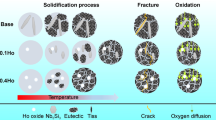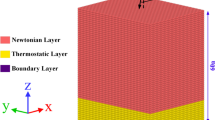Abstract
The impact of solute Al on the penetration of Cu atoms into the Fe grain boundary (GB) in the Fe–Cu embrittlement system was investigated by performing molecular dynamics simulations. Furthermore, the first principle density functional theory calculation was also employed to determine the binding properties and the electronic structure of GBs doped with solute atoms. The inhibition mechanism of liquid metal embrittlement (LME) cracks in the Fe–Cu system by Al was analyzed at the atomic scale by conducting simulations and calculations. The results show that the diffusion rate of Al along with the GB direction was much higher than that of Cu, and the preferential penetration and segregation of Al atoms acted as a barrier layer. Moreover, the addition of Al reduced the potential energy of Cu atoms, thus stabilizing their motion. These factors significantly inhibited the diffusion of Cu atoms along with the GB direction. The binding property of Fe GB doped with a high concentration of Cu was severely deteriorated, while the Al doping improved the atomic bonding. GBs with higher binding properties are less susceptible to fracture and groove under the application of tensile stress. This paper presents a novel perspective on the inhibition mechanism of LME cracks by doping a third component to inhibit the penetration of embrittlement atoms.








Similar content being viewed by others
Data availability
Data will be made available on request.
References
Shen M, Li Y, Hu C, Xue S, Xiang C, Luo J, Yu Z (2021) The interfacial structure underpinning the Al–Ga liquid metal embrittlement: disorder vs. order gradients. Scr Mater 204:114149. https://doi.org/10.1016/j.scriptamat.2021.114149
Yu ZY, Cantwell PR, Gao Q, Yin D, Zhang YY, Zhou NX, Rohrer GS, Widom M, Luo J, Harmer MP (2017) Segregation-induced ordered superstructures at general grain boundaries in a nickel-bismuth alloy. Science 358:97–101. https://doi.org/10.1126/science.aam8256
Luo J, Cheng H, Asl KM, Kiely CJ, Harmer MP (2011) The role of a bilayer interfacial phase on liquid metal embrittlement. Science 333:1730–1733. https://doi.org/10.1126/science.1208774
Kundu A, Asl KM, Luo J, Harmer MP (2013) Identification of a bilayer grain boundary complexion in Bi-doped Cu. Scr Mater 68:146–149. https://doi.org/10.1016/j.scriptamat.2012.10.012
Nam H-S, Srolovitz DJ (2007) Molecular dynamics simulation of Ga penetration along Σ5 symmetric tilt grain boundaries in an Al bicrystal. Phys Rev B 76:184114. https://doi.org/10.1103/PhysRevB.76.184114
Xu C, Wei J, Huang B, Meng X, Xiao S, Deng H, Hu W (2020) Effect of symmetrical tilt grain boundary on the compatibility between copper and liquid lithium: atomistic simulations. J Alloys Compd 835:155212. https://doi.org/10.1016/j.jallcom.2020.155212
Yang S, Zhou N, Zheng H, Ong SP, Luo J (2018) First-order interfacial transformations with a critical point: breaking the symmetry at a symmetric tilt grain boundary. Phys Rev Lett 120:085702. https://doi.org/10.1103/PhysRevLett.120.085702
Lu M, Wang F, Zeng X, Chen W, Zhang J (2020) Cohesive zone modeling for crack propagation in polycrystalline NiTi alloys using molecular dynamics. Theor Appl Fract Mech 105:102402. https://doi.org/10.1016/j.tafmec.2019.102402
Cao D, Malakooti S, Kulkarni VN, Ren Y, Lu H (2021) Nanoindentation measurement of core–skin interphase viscoelastic properties in a sandwich glass composite. Mech Time-Depend Mater 25:353–363. https://doi.org/10.1007/s11043-020-09448-y
Cao D, Malakooti S, Kulkarni VN, Ren Y, Liu Y, Nie X, Qian D, Griffith DT, Lu H (2022) The effect of resin uptake on the flexural properties of compression molded sandwich composites. Wind Energy 25:71–93. https://doi.org/10.1002/we.2661
Wang X, Xu T, de Andrade MJ, Rampalli I, Cao D, Haque M, Roy S, Baughman RH, Lu H (2021) The interfacial shear strength of carbon nanotube sheet modified carbon fiber composites. In: Challenges in mechanics of time dependent materials, volume 2: proceedings of the 2020 annual conference on experimental and applied mechanics. Springer, Berlin, pp 25–32. https://doi.org/10.1007/978-3-030-59542-5_4
Peng W, Peng H, Wu G, Zhang J (2020) Effect of zinc-doping on tensile strength of Σ5 bcc Fe symmetric tilt grain boundary. Comput Mater Sci 171:109204. https://doi.org/10.1016/j.commatsci.2019.109204
Zhang Y, Lu G-H, Kohyama M, Wang T (2009) Investigating the effects of a Ga layer on an Al grain boundary by a first-principles computational tensile test. Model Simul Mater Sci Eng 17:015003. https://doi.org/10.1088/0965-0393/17/1/015003
Rajagopalan M, Bhatia MA, Tschopp MA, Srolovitz DJ, Solanki KN (2014) Atomic-scale analysis of liquid-gallium embrittlement of aluminum grain boundaries. Acta Mater 73:312–325. https://doi.org/10.1016/j.actamat.2014.04.011
Liu T, Hui J, Zhang B, He X, Liu M, Qiu J, Liu W (2022) Corrosion mechanism of lead-bismuth eutectic at grain boundary in ferritic steels and the effect of alloying elements: a first-principles study. J Nucl Mater 569:153915. https://doi.org/10.1016/j.jnucmat.2022.153915
Chen S, Yu X, Huang J, Yang J, Lin S (2019) Interfacial ferrite band formation to suppress intergranular liquid copper penetration of solid steel. J Alloys Compd 773:719–729. https://doi.org/10.1016/j.jallcom.2018.09.282
Wang S, Chen C, Ju J, Zhou J, Xue F (2023) Suppression of LME cracks in Sn bronze-steel system based on multi-material additive manufacturing. Mater Lett 335:133775. https://doi.org/10.1016/j.matlet.2022.133775
Wang S, Chen C, Ju J, Zhou J, Xue F (2023) Effect of Al bronze interlayer on liquid–solid compound interface of Sn bronze/steel. Adv Eng Mater 25:2201227. https://doi.org/10.1002/adem.202201227
Deluigi OR, Pasianot RC, Valencia FJ, Caro A, Farkas D, Bringa EM (2021) Simulations of primary damage in a high entropy alloy: probing enhanced radiation resistance. Acta Mater 213:116951. https://doi.org/10.1016/j.actamat.2021.116951
Zhou XW, Johnson RA, Wadley HNG (2004) Misfit-energy-increasing dislocations in vapor-deposited CoFe/NiFe multilayers. Phys Rev B 69:144113. https://doi.org/10.1103/PhysRevB.69.144113
Clark SJ, Segall MD, Pickard CJ, Hasnip PJ, Probert MJ, Refson K, Payne MC (2005) First principles methods using CASTEP. Z Kristallogr Cryst Mater 220:567–570. https://doi.org/10.1524/zkri.220.5.567.65075
Laasonen K, Pasquarello A, Car R, Lee C, Vanderbilt D (1993) Car–Parrinello molecular dynamics with Vanderbilt ultrasoft pseudopotentials. Phys Rev B 47:10142–10153. https://doi.org/10.1103/PhysRevB.47.10142
Perdew JP, Burke K, Ernzerhof M (1996) Generalized gradient approximation made simple. Phys Rev Lett 77:3865–3868. https://doi.org/10.1103/PhysRevLett.77.3865
Head JD, Zerner MC (1985) A Broyden—Fletcher—Goldfarb—Shanno optimization procedure for molecular geometries. Chem Phys Lett 122:264–270. https://doi.org/10.1016/0009-2614(85)80574-1
Meng F-S, Liu Y-L, Zhang H, Li J-H, Zhao X, Qi Y (2018) Metastable state in a tensile-strained Cu Σ5 grain boundary: a first-principles study. Phys Rev B 97:054101. https://doi.org/10.1103/PhysRevB.97.054101
Liu W, Han H, Ren C, He X, Jia Y, Wang S, Zhang W, Li Z, Zhou X, Zou Y, Huai P, Xu H (2014) First-principles study of intergranular embrittlement induced by Te in the Ni Σ 5 grain boundary. Comput Mater Sci 88:22–27. https://doi.org/10.1016/j.commatsci.2014.02.038
Xiao Z, Hu J, Liu Y, Dong F, Huang Y (2019) Segregation of Sc and its effects on the strength of Al Σ5 (210) [100] symmetrical tilt grain boundary. Mater Sci Eng A 756:389–395. https://doi.org/10.1016/j.msea.2019.04.070
Cao F-H, Wang Y-J, Dai L-H (2020) Novel atomic-scale mechanism of incipient plasticity in a chemically complex CrCoNi medium-entropy alloy associated with inhomogeneity in local chemical environment. Acta Mater 194:283–294. https://doi.org/10.1016/j.actamat.2020.05.042
Sadigh B, Erhart P, Stukowski A, Caro A, Martinez E, Zepeda-Ruiz L (2012) Scalable parallel Monte Carlo algorithm for atomistic simulations of precipitation in alloys. Phys Rev B 85:184203. https://doi.org/10.1103/PhysRevB.85.184203
Klinger L, Rabkin E (2011) Theory of the Kirkendall effect during grain boundary interdiffusion. Acta Mater 59:1389–1399. https://doi.org/10.1016/j.actamat.2010.10.070
Klinger L, Rabkin E (2011) Stress generation during grain boundary interdiffusion. Defect Diffus Forum 309–310:19–28. https://doi.org/10.4028/www.scientific.net/DDF.309-310.19
Glickman EE (2011) Dissolution condensation mechanism of stress corrosion cracking in liquid metals: driving force and crack kinetics. Metall Mater Trans A 42:250–266. https://doi.org/10.1007/s11661-010-0429-6
Acknowledgements
This work was supported by the National Key Research and Development Program of China (Grant Number 2016YFC1102402).
Author information
Authors and Affiliations
Contributions
SW contributed to investigation, formal analysis, software, visualization, writing—original draft, writing—review and editing. XC contributed to resources, investigation. ZW contributed to resources, investigation. JJ contributed to resources, investigation. JZ contributed to conceptualization, project administration, funding acquisition. FX contributed to methodology, supervision.
Corresponding author
Ethics declarations
Conflict of interest
The authors declare that they have no known conflicts of interest or competing interests.
Ethical approval
Not applicable.
Additional information
Handling Editor: Ghanshyam Pilania.
Publisher's Note
Springer Nature remains neutral with regard to jurisdictional claims in published maps and institutional affiliations.
Supplementary Information
Below is the link to the electronic supplementary material.
Rights and permissions
Springer Nature or its licensor (e.g. a society or other partner) holds exclusive rights to this article under a publishing agreement with the author(s) or other rightsholder(s); author self-archiving of the accepted manuscript version of this article is solely governed by the terms of such publishing agreement and applicable law.
About this article
Cite this article
Wang, S., Cai, X., Wang, Z. et al. The inhibition mechanism of liquid metal embrittlement cracks in the Fe–Cu system by Al: atomistic simulations and calculations. J Mater Sci 58, 12673–12684 (2023). https://doi.org/10.1007/s10853-023-08790-z
Received:
Accepted:
Published:
Issue Date:
DOI: https://doi.org/10.1007/s10853-023-08790-z




